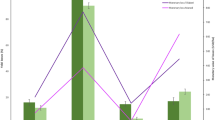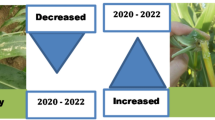Abstract
A survey among 240 resource-poor farmers at the Kenya coast indicated that insect pests were considered to be the main production constraint. Over 70% of respondents mentioned stemborers to be the most important insect pest. Unlike the eggs and adults, stemborer larvae and pupae were frequently seen by farmers. Alternative gramineous host plants for pests were common near maize fields and were often not destroyed until after the first rains. Nearly all farmers left dry stems and stubble in the field after harvest. Farmers knew of many methods for controlling stemborers, but only 32 and 56% of farmers in Kilifi and Kwale Districts, respectively, used any of the methods. Chemical control was the most popular control method, being applied regularly by 19 and 38% of farmers in Kilifi and Kwale Districts, respectively. Traditional methods and cultural control methods were seldom used. Approximately 50% of farmers had heard of beneficial insects, with farmers collectively mentioning 17 predators of stemborers. Cocoons of the parasitoids Cotesia flavipes, released in a biological control programme in the study area in 1993, and the indigenous Cotesia sesamiae had been seen by 33% of respondents, but none knew what these were. The results of the present study stress the need to educate farmers about the biology and ecology of stemborers and the role of natural enemies. Also, after effective control methods suitable for resource-poor farmers have been identified, both groups should be trained in pest management methods, for example through the Farmers Field School approach.
Résumé
Une enquête couvrant 240 fermiers de la côte du Kenya a montré que les insectes ravageurs sont considérés comme les principaux facteurs limitants la production. Plus de 79% des personnes intérrogées ont cité les foreurs de tiges comme les insectes ravageurs les plus importants. Les fermiers ont fréquemment observé les larves et les pupes des foreurs de tiges et très peu les oeufs et les adults. D’autres graminés, plantes hôtes secondaires des foreurs de tiges, ont souvent été observées près des champs de maïs, et ces plantes n’étaient détruites qu’apres les premières pluies. Presque tous les fermiers ont laissé des tiges séchées et des chaumes dans leurs champs après les récoltes. Les fermiers connaissaient plusieurs méthodes de lutte, toutefois, 32 et 56% seulement de fermiers dans les districts de Kilifi et Kwale, respectivement, ont utilisé l’une de ces méthodes. La lutte chimique était la plus fréquement utilisée. Elle était pratiquée régulièrement par 19 et 38% des fermiers des districts de Kilifi et de Kwale, respectivement. Les méthodes de luttes traditionelles et cuturales étaient très peu utilisées. Une cinquantaine de fermiers ont entendu parlé d’insectes bénéfiques. Les fermiers ont cité 17 prédateurs des foreurs de tiges. Les cocons du parasitoid, Cotesia flavipes qui a été lâché dans la région en 1993 lors d’un programme de lutte biologique, et ceux du parasitoid local, Cotesia sesamiae ont déjà été observés par 33% des fermiers mais aucun ne savait ce que c’était. Les résultats de cette étude souligne le besoin d’éduquer les paysans sur la biologie et l’écologie des foreurs de tiges ainsi que sur le rôle de leurs ennemis naturels. Aussi, lorsque des méthodes de luttes efficaces adaptées aux fermiers aux revenus faibles, sont identifiées, les paysans devraient êrre formés. Cette formation pourrait ce faire à travers “les écoles de fermiers”.
Similar content being viewed by others
References
Grisley W. (1997) Crop-pest yield loss: A diagnostic study in the Kenya highlands. Int. J. Pest Manage. 43, 137–142.
ISERIPM (1997) Technologies for stemborer control on maize in coastal Kenya, a guidebook for extension staff. Social Sciences Department, The International Centre of Insect Physiology and Ecology, Nairobi, Kenya, 12 pp.
Jaetzold R. and Schmidt H. (1983) Farm management handbook of Kenya. Volume II C: Natural conditions and farm management information, East Kenya (Eastern and Coast Provinces). Farm Management Branch, Ministry of Agriculture, Nairobi, Kenya.
Joyce R. J. V. (1976) Insect flight in relation to problems of pest control, pp. 135–155. In Insect Flight (Edited by R.C. Rainey). Blackwells, Oxford.
Kenmore P. E. (1997) A perspective on IPM. ILEIA Newsletter 13, 8–9.
Kfir R. (1997) Natural control of the cereal stemborers Busseola fusca and Chilo partellus in South Africa. Insect Sci. Applic. 17, 61–68.
Khan Z. R., Chiliswa P., Ampong-Nyarko K., Smart L. E., Polaszek A., Wandera J. and Mulaa M. A. (1997) Utilisation of wild gramineous plants for management of cereal stemborers in Africa. Insect Sci. Applic. 17, 143–150.
Loevinsohn M., Meijerink G. and Salasya B. (1998) Integrated Pest Management in Smallholder Farming Systems in Kenya. Evaluation of a pilot project. International Service for National Agricultural Research and Kenyan Agricultural Research Institute. April 1998.
Matteson P., Altieri M. and Gagne W. (1984) Modification of small farmer practices for better pest management. Annu. Rev. Entomol. 29, 383–402.
Nwanze K. E and Muller R. A. E. (1989) Management options for sorghum stemborers for farmers in the semi-arid tropics. In International Workshop on Sorghum Stemborers, 17–20 November 1987. ICRISAT, Patancheru, India.
Nyambo B. T. and Kimani M. (1998) Role of information in IPM Farmer Field Schools: Experiences in Kenya. Paper prepared for the Workshop on IPM Communications in East and Southern Africa, 2–6 March 1998, ICIPE, Nairobi, Kenya.
Nyambo B. T. and Mwangi M. (1991) Management of maize and sorghum stalks and residues by small-scale farmers and its implications for IPM control strategies in Kenya, pp. 55–63. In Proceedings of a Seminar on Crop Protection for Resource-poor Farmers. 4–8 November 1991, United Kingdom (Edited by Gibson R.W. and Sweetmore A.).
Nye I. W. B. (1960) The insect pests of graminaceous crops in East Africa. Colonial Research Studies No. 31. Her Majesty’s Stationery Office, London.
Overholt W. A., Ogeda K. and Lammers P. M. (1994) Distribution and sampling of C. partellus (Swinhoe) (Lepidoptera: Pyralidae) in maize and sorghum at the Kenyan Coast. Bull. Entomol. Res. 84, 367–378.
Päts P. (1996) Management of crop residues to reduce the aestivating population of stemborers in maize. Int. J. Pest Manage. 42, 151–156.
Saxena K. N„ Pala Okeyo A., Seshu Reddy K. V., Omolo E. O. and Ngode L. (1989) Insect pest management and socio-economic circumstances of small-scale farmers for food crop production in western Kenya: A case study. Insect Sci. Applic. 10, 443–462.
Schulthess F., Bosque-Pérez N. A., Chabi-Olaye A., Gounou S., Ndemah R. and Goergen G. (1997) Exchange of natural enemies of lepidopteran cereal stemborers between African regions. Insect Sci. Applic. 17, 97–108.
Smit N. E. J. M. and Matengo L. O. (1995) Farmers’ cultural practices and their effects on pest control in sweetpotato in South Nyanza, Kenya. Int. J. Pest Manage. 41, 2–7.
Songa J. (2000) Survey on maize production systems and pests of maize with emphasis on stemborers in the semi-arid eastern Kenya. Afr. Crop Sci. J. (In press).
Van Huis A. and Meerman F. (1997) Can we make IPM work for resource-poor farmers in sub-Saharan Africa? Int. J. Pest Manage. 43, 313–320.
Van Oosten C. (1989) Farming systems and food security in Kwale District, Kenya. Food and Nutrition Planning Unit, Ministry of Planning and National Development, Nairobi, Kenya; and African Studies Centre, Leiden, The Netherlands. Report No. 30/1989.
Warui C. M. and Kuria J. N. (1983) Population incidence and the control of maize stalkborers Chilo partellus (Swinh.) and Chilo orichalcociliellus Strand and Sesamia calamistis Hmps. in Coast Province, Kenya. Insect Sci. Applic. 4, 11–18.
Author information
Authors and Affiliations
Corresponding author
Rights and permissions
About this article
Cite this article
Bonhof, M.J., van Huis, A., Kiros, F.G. et al. Farmers’ Perceptions of Importance, Control Methods and Natural Enemies of Maize Stemborers at the Kenya Coast. Int J Trop Insect Sci 21, 33–42 (2001). https://doi.org/10.1017/S1742758400020026
Accepted:
Published:
Issue Date:
DOI: https://doi.org/10.1017/S1742758400020026




